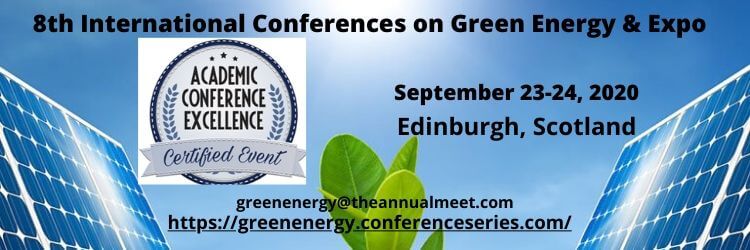Theme: Green Energy for a sustainable future
Green Energy 2020
Conference series LLC welcomes you to attend the 4th International Conference on Green Energy & Expo during November 23-24, 2020 at Edinburgh, Scotland. We cordially invite all the participants interested in sharing their knowledge and research in the arena of renewable energy and environmental sciences.
Green Energy- 2020 provides a platform for researchers/scientists to share and globalize their research work while the participants from industry can promote their products thus felicitating dissemination of knowledge. We anticipate more than 300 participants around the globe with thought provoking keynote lectures, oral and poster presentations. The attending delegates include Editorial Board Members of related journals. The scope of Green Energy -2020 is to bring the advancements in the field of renewable energy and environmental sciences.
Track 1: Renewable Energy
Sustainable Energy or Green Energy is derived from non-conventional energy which is continuously replenished by natural processes. Renewable Energy has attracted a lot of attention in the recent past owing to exhaustion of fossil fuels and in the lookout for alternate energy for a clean and green future. Various forms of renewable energy include solar energy, wind energy, hydro energy, geothermal energy, wave and tidal energy. Based on REN21's 2018 report, renewables contributed 19 percent to our energy consumption and 22 percent to our electricity generation in 2016 and 2017. Renewable power is cost effective, reliable, sustainable, and environmentally friendly. Today the renewable energy sector is already providing more than 450,000 jobs and has an annual turnover exceeding 90 billion Euros. Since 2009, 35 solar projects totalling more than 16,000 megawatts, and 18 wind projects totalling more than 8,000 megawatts, have been approved on public lands in the U.S. That’s enough electricity to power nearly 4 million American homes.
Track 2:Biofuels
Biofuels are produced from living organisms or from metabolic by-products (organic or food waste products). Biodiesel is a form of diesel fuel manufactured from vegetable oils, animal fats, or recycled restaurant greases. It is safe, biodegradable, and produces less air pollutants than petroleum-based diesel. Biodiesel can be used in its pure form (B100) or blended with petroleum diesel. Common blends include B2 (2% biodiesel), B5, and B20.The 93 billion liters of biofuels produced worldwide in 2009 displaced the equivalent of an estimated 68 billion liters of gasoline, equal to about 5% of world gasoline production. Two most common types of biofuels used are ethanol and biodiesel are derived from naturally occurring plants, alcohol and vegetable oil which act as a perfect substitute for fossil fuel.
Track 3: Bioenergy
Bioenergy is renewable energy made available from materials derived from biological sources. Though wood is still our largest biomass energy resource, the other sources which can be utilized include plants, residues from agriculture or forestry, and the organic component of municipal and industrial wastes. Even the fumes from landfills can be used as a biomass energy source. Biohydrogen is a potential biofuel obtainable from both cultivation and from waste organic materials. Though hydrogen is produced from non renewable technologies such as steam reformation of natural gas (~50% of global H2 supply), petroleum refining (~30%) and gasification of coal (~20%), green algae (including Chlamydomonas reinhardtii) and cyanobacteria offer an alternative route to renewable H2 production. Steam reforming of methane (biogas) produced by anaerobic digestion of organic waste, can be utilized for biohydrogen as well. According to European Bioplastics a plastic material is defined as a bioplastic if it is either biobased, biodegradable, or features both properties. In search of new material solutions and keeping an eye on the goal of sustainable production and consumption, bioplastics have several (potential) advantages. Bioelectricity is the production of electric potentials and currents within/by living organisms. Bioelectric potentials are generated by a variety of biological processes and generally range in strength from one to a few hundred millivolts.
Track 4: Green Technology
Green Technology refers to the application of technology from clean & environmental friendly resources and materials in every sphere like generation, distribution and storage of energy, transport and architecture which enables us to conserve natural resources. Its main objective is to find ways to create new technologies in such a way that they do not damage or deplete the planet’s natural resources and aid in reduction of global warming, greenhouse effect, pollution and climate change.
Track 5: Energy Conservation
Utilization of renewable energy sources in the industrial sector is yet to improve as it has in the field of its utilization for power generation due to greater scope of improvement with reference to CO2 capture and storage and energy efficiency. Combined with improvements in energy efficiency and the rational use of energy, renewable energy sources can provide everything fossil fuels currently offer in terms of energy services such as heating and cooling, electricity and also transport fuel. Conservation is the process of reducing demand on a limited supply and enabling that supply to begin to rebuild itself. Many times the best way of doing this is to replace the energy used with an alternate. The goal with energy conservation techniques is reduce demand, protect and replenish supplies, develop and use alternative energy sources, and to clean up the damage from the prior energy processes. Carbon Capture and Storage (CCS) is a technology that can capture up to 90% of the carbon dioxide (CO2) emissions produced from the use of fossil fuels in electricity generation and industrial processes, preventing the carbon dioxide from entering the atmosphere.
Track 6: Sustainable Energy Policies
There are various energy policies on a global scale in relation to energy exploration, production and consumption, ranging from commodities companies to automobile manufacturers to wind and solar producers and industry associations. Recent focus of energy economics includes the following issues: Climate change and climate policy, sustainability, energy markets and economic growth, economics of energy infrastructure, energy and environmental law and policies and global warming along with exploring various challenges associated with accelerating the diffusion of renewable energy technologies in developing countries.
Track 7: Green Economy
The United Nations Environment Program (UNEP) has defined green economy as one that results in improved human well-being and social equity, while significantly reducing environmental risks and ecological scarcities. In its simplest expression, a green economy can be thought of as one which is low carbon, resource efficient and socially inclusive.
Track 8: Energy and Environment
Energy and environment are co-related in the technological and scientific aspects including energy conservation, and the interaction of energy forms and systems with the physical environment. The levels of atmospheric carbon dioxide has increased by 31% between 1800 and 2000, going from 280 parts per million to 367 parts per million. Scientists predict that carbon dioxide levels could be as high as 970 parts per million by the year 2100. Different factors are responsible for this development, such as progress with respect to technical parameters of energy converters, in particular, improved efficiency; emissions characteristics and increased lifetime. Various environmental policies have been implemented across the globe for reduction of GHG emissions for improvement of environment.
Track 9: Nano Environmental Technologies
Application of nanotechnology which involves the manipulation of materials at the scale of the nanometer to green engineering principles is "Green nanotechnology". Maintaining and improving soil, water, and air quality represent some of the most formidable challenges facing global society in the 21st century. Pollutants from such diverse sources as oil and chemical spills, pesticide and fertilizer runoff, abandoned industrial and mining sites, and airborne gaseous and particulate matter from automobiles exacerbate the situation on a daily basis. Detecting and treating existing contaminants and preventing new pollution are among the challenges. Application of nanomaterials in diverse fields such as enhancing the production and refining of fuels and reduction of emissions from automobiles, energy storage (batteries and nano-enabled fuel cells),to provide safe drinking water through improved water treatment, desalination, nano-enabled insulation and design of nanomaterials for pollution sensing and detection.
Track 10:Bioremediation
Bioremediation is a waste management technique that involves the use of organisms to remove or neutralize pollutants from a contaminated site. Technologies can be generally classified as in situ or ex situ. In situ bioremediation involves treating the contaminated material at the site, while ex situ involves the removal of the contaminated material to be treated elsewhere. Bioremediation may occur on its own (natural attenuation or intrinsic bioremediation) or may only effectively occur through the addition of fertilizers, oxygen, etc., that help encourage the growth of the pollution-eating microbes within the medium. However, not all contaminants are easily treated by bioremediation using microorganisms. Phytoremediation is useful in these circumstances because natural plants or transgenic plants are able to bioaccumulation these toxins in their above-ground parts, which are then harvested for removal.
Conference series LLC welcomes you to attend the 8th International Conference on Green Energy & Expo during November 23-24, 2020 at Edinburgh, Scotland . We cordially invite all the participants interested in sharing their knowledge and research in the arena of renewable energy and environmental sciences.
Green Energy- 2020 provides a platform for researchers/scientists to share and globalize their research work while the participants from industry can promote their products thus felicitating dissemination of knowledge. We anticipate more than 300 participants around the globe with thought provoking keynote lectures, oral and poster presentations. The attending delegates include Editorial Board Members of related journals. The scope of Green Energy -2020 is to bring the advancements in the field of renewable energy and environmental sciences.
Why to attend?
Meet the eminent researchers working in the allied areas of renewable energy and Technology. This conference will be the best platform to explore your research work and innovations in the respective areas. This conference is focused on all the major fields of Green Energy.
With members from around the world focused on learning about Green Energy, this is your single best opportunity to reach the largest assemblage of participants from various communities, conduct demonstrations, distribute information, meet with current and potential speakers and receive recognition at this 2-day event. The hallmark of this conference is our world-renowned speakers, the most recent techniques, latest advancements updates in Green Energy field.
Importance & Scope:
Green Energy is a pre-requisite for a clean future and for reducing our dependence upon the depleting fossil fuels. The purpose is to stimulate discussion of new ideas and/or find new perspectives on traditional methods related to Renewable Energy sources and systems. Green Energy conference will provide a comprehensive view of the latest developments relating utilization of renewable energy around the world.
Green Energy-2020 would serve as an enlightening source for multidisciplinary area that monitors renewable Energy sources and systems, industrial applications, energy storage and network, Environmental impact, energy conservation, law, improved energy efficiency in buildings and latest trends and technologies for utilization of natural resources along with nanotechnology applications and energy solutions.
Why Edinburgh?
Edinburgh is the capital of Scotland and one of its 32 council areas. Historically part of the county of Midlothian (interchangeably Edinburghshire before 1921), it is located in Lothian on the Firth of Forth's southern shore.
Recognised as the capital of Scotland since at least the 15th century, Edinburgh is the seat of the Scottish Government, the Scottish Parliament and the supreme courts of Scotland. The city's Palace of Holyroodhouse is the official residence of the monarch in Scotland. The city has long been a centre of education, particularly in the fields of medicine, Scots law, literature, philosophy, the sciences and engineering. It is the second largest financial centre in the United Kingdom (after London)and the city's historical and cultural attractions have made it the United Kingdom's second most popular tourist destination attracting 1.75 million visits from overseas in 2016.
Edinburgh is Scotland's second most populous city and the seventh most populous in the United Kingdom. The official population estimates are 488,050 (2016) for the Locality of Edinburgh (Edinburgh pre 1975 regionalisation plus Currie and Balerno), 518,500 (2018) for the City of Edinburgh, and 1,339,380 (2014) for the city region. Edinburgh lies at the heart of the Edinburgh and South East Scotland city region comprising East Lothian, Edinburgh, Fife, Midlothian, Scottish Borders and West Lothian.
The city is the annual venue of the General Assembly of the Church of Scotland. It is home to national institutions such as the National Museum of Scotland, the National Library of Scotland and the Scottish National Gallery. The University of Edinburgh, founded in 1582 and now one of four in the city, is placed 20th in the QS World University Rankings for 2020.[18] The city is also famous for the Edinburgh International Festival and the Fringe, the latter being the world's largest annual international arts festival. Historic sites in Edinburgh include Edinburgh Castle, the Palace of Holyroodhouse, the churches of St. Giles, Greyfriars and the Canongate, and the extensive Georgian New Town built in the 18th/19th centuries. Edinburgh's Old Town and New Town together are listed as a UNESCO World Heritage site, which has been managed by Edinburgh World Heritage since 1999.
Conference Highlights:
Renewable Energy
Biofuels
Bioenergy
Green Technology
Energy Conservation
Sustainable Energy Policies
Green Economy
Energy and Environment
Nano Environmental Technologies
Bioremediation
Entrepreneurs Investment Meet
Why to attend?
Meet the eminent researchers working in the allied areas of Renewable Energy and Technology. This conference will be the best platform to explore your research work and innovations in the respective areas. This conference is focusing on all the major fields of Green Energy.
With members from around the world focused on learning about Green Energy, this is your single best opportunity to reach the largest assemblage of participants from various communities. Conduct demonstrations, distribute information, meet with current and potential speakers and receive name recognition at this 2-day event. World-renowned speakers, the most recent techniques, tactics, and the latest updates in Green Energy field is hallmark of this conference.
Major Green Energy Associations around the Globe
Renewable Energy Society
The Solar Energy Society (UK-ISES)
SESI (Solar Energy Society of India)
Danish Organization for Renewable Energy (OVE)
European Renewable Energy Council (EREC)
EKOenergy
Renewable Energy and Energy Efficiency Partnership (REEEP)
RenewableUK
Major Green Energy Associations in USA
ISES International Solar Energy Society
American Solar Energy Society (ASES)
Colorado Renewable Energy Society (CRES)
Rocky Mountain Institute
Environmental and Energy Study Institute
Georgia Solar Energy Association
Southeastern Energy Society
Target Audience:
Academicians, Scientists, Business delegates, Experts, Departmental Managers, Vice Presidents/ Directors & Brand Manufacturers/ Marketers of Consumer Products. Solution Providers (digital and mobile technology), Professors and Students from Academia working in the arena of renewable energy.
Researchers 1279
Academia 6495
Students 7718
Glance at Market of Advertising and Marketing:
The global renewable energy market is valued at $224 billion in 2010 and is expected to reach $331 billion by 2015, a compound annual growth rate (CAGR) of 8.1%.
The global market for biofuels was worth $30.3 billion in 2013. This should increase at a CAGR of 7.1% to reach $42.6 billion in 2019. Solar energy will experience the most dramatic growth over the forecast period. This sector is valued at $44 billion in 2013 and should reach $97 billion by 2019, a compound annual growth rate (CAGR) of 17%.
The global photovoltaic (PV) modules market was valued at $32.6 billion in 2013 and $34.6 billion in 2019. The global revenues for energy–efficient technologies in commercial buildings reached nearly $36.3 billion in 2013 and $41 billion in 2014. This market should reach $60.2 billion in 2019, demonstrating a compound annual growth rate (CAGR) of 8% from 2014 to 2019.
The global market for utility-scale electricity storage technology has reached $10.3 billion in 2013. This market is expected to reach nearly $12.1 billion in 2015 and nearly $26.2 billion in 2020, with a compound annual growth rate (CAGR) of 16.4%.
Conference Highlights
- Green Energy
- Renewable Energy
- Sources of energy
- Wind energy
- Waste to Energy
- Solar Energy
- Wave Energy
- Tidal power
- Ocean or Marine Energy
- Geothermal Energy
- Hydroelectric Energy
- Photovoltaic
- Biofuels
- Smart Grid
- Hybrid renewable energy Sources
- Bioremediation
- Distributed Renewable Energy systems
- Sustainable Energy
- Energy Efficiency
- Energy Storage
- Emerging Technology
- Renewable Energy Climate Change
- Bioenergy and Biotechnology
- Power and Energy Engineering
- Nano Environmental Technologies
- Energy Storage and Conservation
To share your views and research, please click here to register for the Conference.
To Collaborate Scientific Professionals around the World
| Conference Date | November 23-24,2020 | ||
| Sponsors & Exhibitors |
|
||
| Speaker Opportunity Closed | Day 1 | ||
| Poster Opportunity Closed | Click Here to View | ||
Useful Links
Special Issues
All accepted abstracts will be published in respective Our International Journals.
- Journal of Fundamentals of Renewable Energy and Applications
- Journal of Biochemical Engineering & Bioprocess Technology
- Environment Pollution and Climate Change
Abstracts will be provided with Digital Object Identifier by




